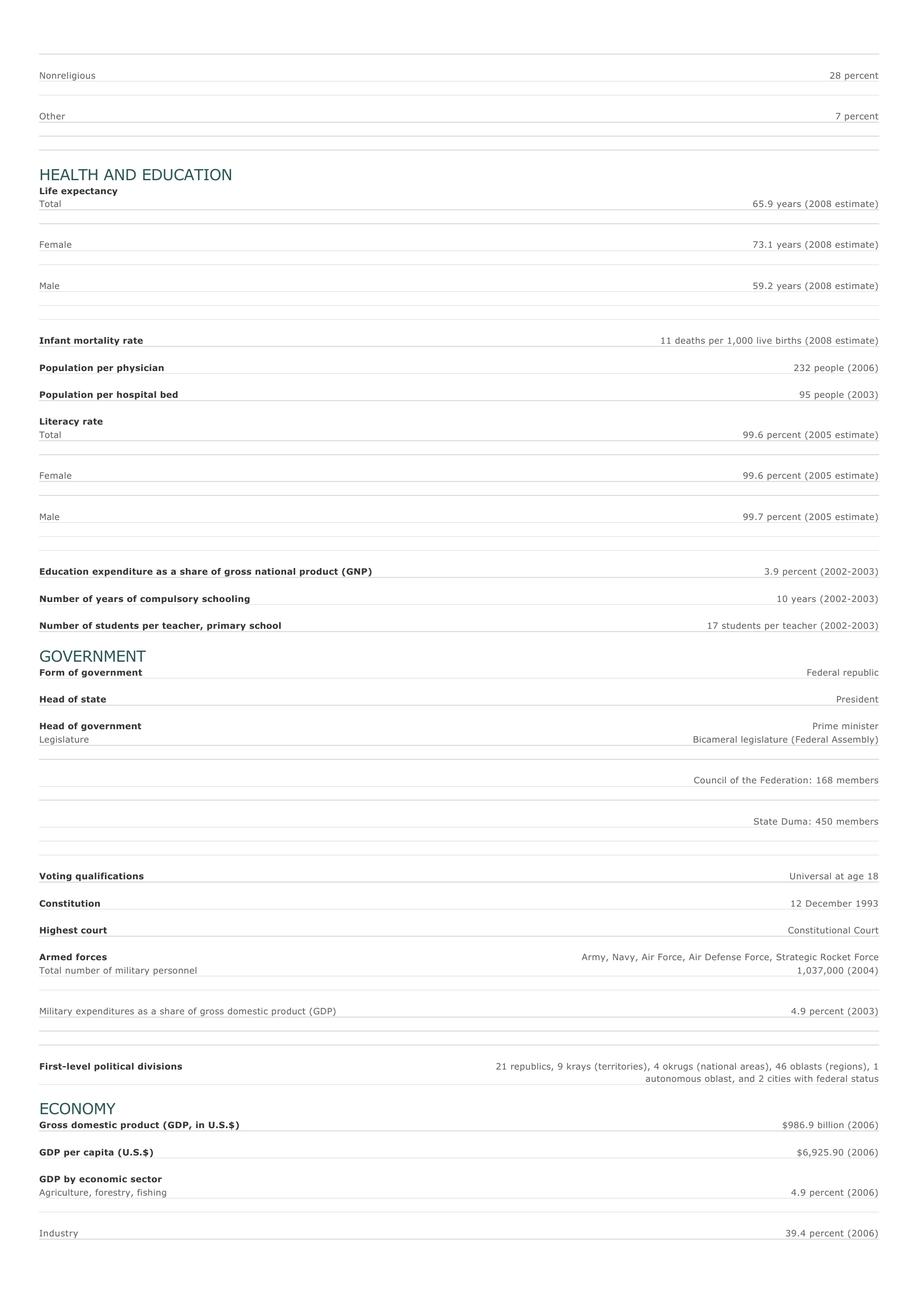Russia Facts and Figures. BASIC FACTS Official name Capital Area Russian Federation Moscow 17,075,200 sq km 6,592,770 sq mi PEOPLE Population 140,702,090 (2008 estimate) Population growth Population growth rate -0.47 percent (2008 estimate) Projected population in 2025 128,180,396 (2025 estimate) Projected population in 2050 109,187,353 (2050 estimate) Population density 8.3 persons per sq km (2008 estimate) 21 persons per sq mi (2008 estimate) Urban/rural distribution Share urban 73 percent (2005 estimate) Share rural 27 percent (2005 estimate) Largest cities, with population Moscow 10,469,000 (2003 estimate) St. Petersburg 4,596,000 (2005 estimate) Nizhniy Novgorod 1,370,200 (2007 estimate) O msk 1,142,773 (2004 estimate) U fa 1,036,026 (2004 estimate) Ethnic groups Russian 81.5 percent Tatar 3.8 percent Ukrainian 3.0 percent Chuvash 1.2 percent Bashkir 0.9 percent Belarusian, Udmurt, Kazakh, Moldovan, Jewish, other 9.6 percent Languages Russian (official), Tatar, Ukrainian, Chuvash, Bashkir, Mordovian, Belarusian, and others Religious affiliations Orthodox (Russian) Christian 52 percent Muslim 8 percent Atheist 5 percent Nonreligious O ther 28 percent 7 percent HEALTH AND EDUCATION Life expectancy Total 65.9 years (2008 estimate) Female 73.1 years (2008 estimate) Male 59.2 years (2008 estimate) Infant mortality rate Population per physician Population per hospital bed 11 deaths per 1,000 live births (2008 estimate) 232 people (2006) 95 people (2003) Literacy rate Total 99.6 percent (2005 estimate) Female 99.6 percent (2005 estimate) Male 99.7 percent (2005 estimate) Education expenditure as a share of gross national product (GNP) Number of years of compulsory schooling Number of students per teacher, primary school 3.9 percent (2002-2003) 10 years (2002-2003) 17 students per teacher (2002-2003) GOVERNMENT Form of government Head of state Head of government Legislature Federal republic President Prime minister Bicameral legislature (Federal Assembly) Council of the Federation: 168 members State Duma: 450 members Voting qualifications Universal at age 18 Constitution 12 December 1993 Highest court Constitutional Court Armed forces Total number of military personnel Military expenditures as a share of gross domestic product (GDP) First-level political divisions Army, Navy, Air Force, Air Defense Force, Strategic Rocket Force 1,037,000 (2004) 4.9 percent (2003) 21 republics, 9 krays (territories), 4 okrugs (national areas), 46 oblasts (regions), 1 autonomous oblast, and 2 cities with federal status ECONOMY Gross domestic product (GDP, in U.S.$) GDP per capita (U.S.$) GDP by economic sector Agriculture, forestry, fishing I ndustry $986.9 billion (2006) $6,925.90 (2006) 4.9 percent (2006) 39.4 percent (2006) Services Employment Number of workers 55.8 percent (2006) 73,528,949 (2006) Workforce share of economic sector Agriculture, forestry, fishing 10 percent (2005) I ndustry 30 percent (2005) Services 60 percent (2005) Unemployment rate 7.9 percent (2004) National budget (U.S.$) Total revenue $284,047 million (2006) Total expenditure $193,042 million (2006) Monetary Unit 1 ruble (R), consisting of 100 kopeks Agriculture Grain, potatoes, livestock, sugar beets Mining Petroleum, natural gas, coal, peat, copper, iron ore, bauxite, lead, phosphate rock, nickel, manganese, gold, diamonds Manufacturing Mining equipment, machinery (including agricultural equipment), transportation equipment (including aircraft, space vehicles, and ships), communications equipment, electric powergenerating and -transmitting equipment, medical and scientific instruments, Major exports Petroleum and petroleum products, natural gas, wood and wood products, metals, chemicals, military manufactures, consumer goods Major imports Machinery, chemicals, consumer goods, grain, meat, sugar, semifinished metal products Major trade partners for exports Germany, Italy, United States, Ukraine, and China Major trade partners for imports Germany, Ukraine, United States, Kazakhstan, and China ENERGY, COMMUNICATIONS, AND TRANSPORTATION Electricity production Electricity from thermal sources 64.70 percent (2003 estimate) Electricity from hydroelectric sources 19.31 percent (2003 estimate) Electricity from nuclear sources 15.67 percent (2003 estimate) Electricity from geothermal, solar, and wind sources 0.32 percent (2003 estimate) Number of radios per 1,000 people 417 (1997) Number of telephones per 1,000 people 280 (2005) Number of televisions per 1,000 people 422 (1998 estimate) Number of Internet hosts per 10,000 people Daily newspaper circulation per 1,000 people 42 (2003) 105 (1996) Number of motor vehicles per 1,000 people Paved road as a share of total roads 175 (2000) 67 percent (1999) SOURCES Basic Facts and People sections Area data are from the statistical bureaus of individual countries. Population, population growth rate, and population projections are from the United States Census Bureau, International Programs Center, International Data Base (IDB) (www.census.gov). Urban and rural population data are from the Food and Agriculture Organization (FAO) of the United Nations (UN), FAOSTAT database (www.fao.org). Largest cities population data and political divisions data are from the statistical bureaus of individual countries. Ethnic divisions and religion data are largely from the latest Central Intelligence Agency (CIA) World Factbook and from various country censuses and reports. Language data are largely from the Ethnologue, Languages of the World, Summer Institute of Linguistics International (www.sil.org). Health and Education section Life expectancy and infant mortality data are from the United States Census Bureau, International Programs Center, International database (IDB) (www.census.gov). Population per physician and population per hospital bed data are from the World Health Organization (WHO) (www.who.int). Education data are from the United Nations Educational, Scientific and Cultural Organization (UNESCO) database (www.unesco.org). Government section Government, independence, legislature, constitution, highest court, and voting qualifications data are largely from various government Web sites, the latest Europa World Yearbook, and the latest Central Intelligence Agency (CIA) World Factbook. The armed forces data is from Military Balance. Economy section Gross domestic product (GDP), GDP per capita, GDP by economic sectors, employment, and national budget data are from the World Bank database (www.worldbank.org). Monetary unit, agriculture, mining, manufacturing, exports, imports, and major trade partner information is from the statistical bureaus of individual countries, latest Europa World Yearbook, and various United Nations and International Monetary Fund (IMF) publications. Energy, Communication, and Transportation section Electricity information is from the Energy Information Administration (EIA) database (www.eia.doe.gov). Radio, telephone, television, and newspaper information is from the United Nations Educational, Scientific and Cultural Organization (UNESCO) database (www.unesco.org). Internet hosts, motor vehicles, and road data are from the World Bank database (www.worldbank.org). Note Figures may not total 100 percent due to rounding. Microsoft ® Encarta ® 2009. © 1993-2008 Microsoft Corporation. All rights reserved.





















